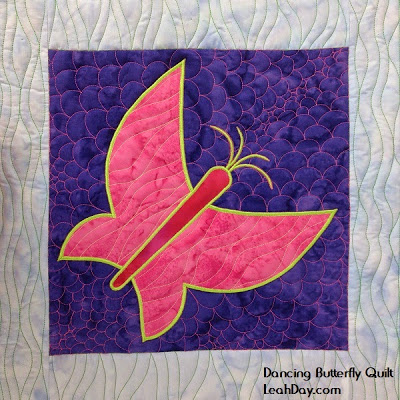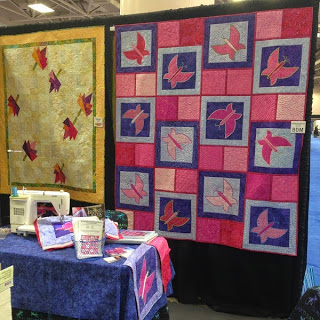Dancing Butterfly Design #22 – Flowing Lines
Flowing Lines is one of my absolute favorite free motion quilting designs. It can honestly stand all on it’s own to make fantastic quilting texture in an art quilt. It can also easily fill in the wings and border of our butterfly block:
The best thing about this free motion quilting design is how simple it is – it’s just gently curving lines, and occasionally you quilt a gap line to create those organic spaces in the design.
You know the most fantastic surprise I’ve had at quilt market? Seeing the Dancing Butterfly Quilt again after more than 6 months, unfolding her for my schoolhouse class and finding it wasn’t crippled with wrinkles!
I used Hobbs Heirloom Wool as the batting for this quilt and I find it made an enormous difference! From now on I know what I’ll be using in show quilts that have to be folded and shipped sometimes months in advance.
So what do you think about flowing lines? Does it seem easy enough to quilt in the borders or sashing of your next quilt? Where do you plan to quilt it next?
Let’s go quilt,
Leah Day




It does look completely easy, and has a nice smooth look. I can see it working as woodgrain (at a smaller scale), too.
Leah, you say you used wool batting…just wondering what your experience with it has been. Is Hobbs' wool the moth-resistant type? I used Quilter's Dream wool last year in a landscape quilt, and later was horrified to find moth larva remains in the leftover batting. Now I'm scared to death moths will eat through the cotton on my quilt to get to the wool batting…so scared that I rolled up the quilt and sealed it with duct tape in two big plastic bags while it's in storage waiting to be sold. I know you're busy, but I'd welcome some feedback from you whenever you get a chance, even if it's months from now! 🙂 Thanks so much.
Linda
Hi Linda – Great question! I don't think any natural fiber material is ever going to be truly bug resistant. Bugs just naturally eat wool and cotton so this is something to always watch out for in your home.
If you are worried that a quilt has been infested, instead of sealing it up, stick it in the freezer. I read about this from a IQSCM online exhibition you can find here – http://www.quiltstudy.org/exhibitions/online_exhibitions/qutm/quilt_care.html
In short – I don't think wool batting will make your quilt any more vulnerable to moth damage than cotton. Instead, keep a very close eye on where you store your quilts and fabric and keep a sharp eye for any moths or bugs that get into the house.
I'm personally so pleased with the Hobbs Heirloom wool I used in the Dancing Butterfly Quilt. This quilt was folded for MONTHS before market and I shook it out for the first time right before a presentation and it didn't have deep creases. I was expecting my poor quilt to be crippled, but it was hardly wrinkled. The wool really makes a big difference in that regard and will now be my #1 choice for any quilts that need to ship and be stored folded.
p.s. Forgot to mention, I'm now keeping a bunch of dried lavender leaves in that closet. Won't stink up the stored quilts and I heard that moths don't like it. Let's hope that's true!
Leah, thanks so much for responding, and so quickly! Well I can't do the freezer because the quilt can't be folded, but your reply gives me some hope…I mean, if you had it folded up somewhere for months and don't see any damage, maybe moths aren't interested in eating through layers of fabric to get at the batting. Maybe they only go after the bare batting! That would be great. By the way, your quilt looks wonderful, and the fact that it didn't take a crease after all that time is indeed very impressive. Makes me want to use wool batting in a bed quilt. For landscapes, though, which are too stiff (and in this case too big) to put in the freezer, maybe I'd better stick to poly! Thanks again so much.